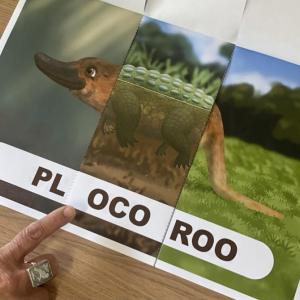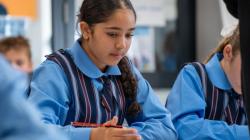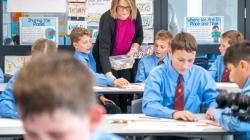'Multiplication: What is a Plocoroo' is a reimagining of classic sequence 'Cartesian Product'
- On the 'In this sequence' tab you'll find all the tasks in this sequence, a suggested implementation plan and curriculum alignment.
- The 'Behind this sequence' tab shows how key mathematical ideas develop over the sequence.
- Have you taught this sequence? Use the Feedback button to let us know how it went!
Tasks in this sequence
Task 1 • Ten heads, ten bodies, ten tails
Students determine how many different animal combinations are possible using ten heads, ten bodies and ten tails.
Task 2 • How many animals?
Students calculate the number of heads, bodies and tails are required to make a book with more than 100 but fewer than 200 different animal combinations.
Suggested implementation
| Monday | Task 1 • Ten heads, ten bodies, ten tails |
|---|---|
| Tuesday | Task 2 • How many animals? |
| Wednesday | Additional activity • Making books |
Curriculum and syllabus alignment
Achievement standards
Students use their proficiency with multiplication facts and efficient calculation strategies to multiply large numbers by one- and two-digit numbers and divide by single-digit numbers. They apply properties of numbers and operations to find unknown values in numerical equations involving multiplication and division.
Australian Curriculum V9 alignment
Number
Solve problems involving multiplication of larger numbers by one- or two-digit numbers, choosing efficient calculation strategies and using digital tools where appropriate; check the reasonableness of answers
Multiplication is a central element of number in the primary years of school. Much time is spent building the concepts of rate and equal groups, particularly through the array representation. Another important concept, yet often overlooked, is that of “for each”. This sequence uses Cartesian product to explore this idea. Students explore how many different combinations can be made in a flip book with ten animal heads, ten bodies, and ten tails. Students are introduced to using a tree diagram to model possible combinations and, through this diagram, learn that the number of features in each category are multiplied to find the total number of combinations that can be made.
Sequence framework
| Learning goals | Students’ mathematical activity | Representation | Context | |
|---|---|---|---|---|
| Task 1 | “For each” is a key multiplicative idea. Tree diagrams make the multiplicative structure in “for each” problems visible, by showing how each choice connects to several others. | Students explore the number of possible combinations of 10 heads, 10 bodies and 10 tails. They use a simpler problem to solve the more complex problem. | Students are introduced to a tree diagram as a way of showing all possible combinations for a smaller problem. | The number of different animal combinations in a flip book. |
| Task 2 | Tree diagrams make the multiplicative structure in “for each” problems visible, by showing how each choice connects to several others. In “for each” problems, the total number of combinations can be found by multiplying the number of options for each part. | Students determine the number of heads, bodies and tails needed to create a book with 100-200 different animal combinations. They connect a tree diagram with symbolic representations of the problem. | Students use a tree diagram to show all possible combinations. They are introduced to multiplication to symbolically record and calculate possible combinations. | The number of different animal combinations in a flip book. |



